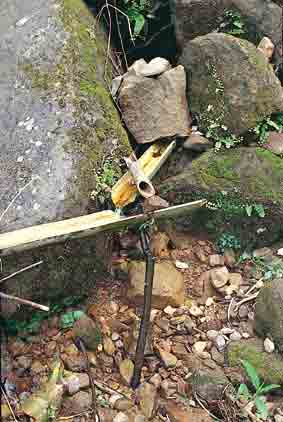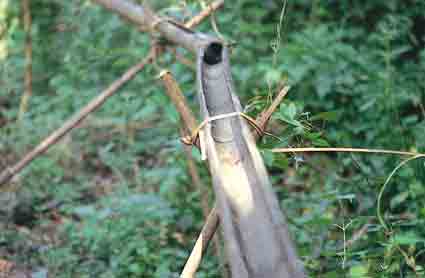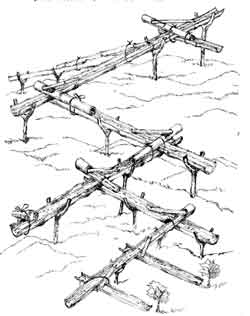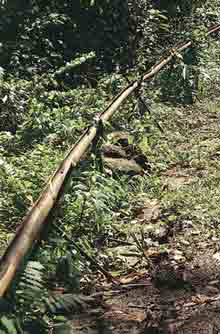 In Meghalaya (one of the seven northeastern states in India), an
ingenious system of tapping of stream and springwater by using bamboo pipes to irrigate
plantations is widely prevalent. It is so perfected that about 18-20 litres of water
entering the bamboo pipe system per minute gets transported over several hundred metres
and finally gets reduced to 20-80 drops per minute at the site of the plant. The tribal
farmers of Khasi and Jaintia hills use the 200-year-old system. In Meghalaya (one of the seven northeastern states in India), an
ingenious system of tapping of stream and springwater by using bamboo pipes to irrigate
plantations is widely prevalent. It is so perfected that about 18-20 litres of water
entering the bamboo pipe system per minute gets transported over several hundred metres
and finally gets reduced to 20-80 drops per minute at the site of the plant. The tribal
farmers of Khasi and Jaintia hills use the 200-year-old system.
The bamboo drip irrigation system is normally used to irrigate the
betel leaf or black pepper crops planted in arecanut orchards or in mixed orchards. Bamboo
pipes are used to divert perennial springs on the hilltops to the lower reaches by
gravity. The channel sections, made of bamboo, divert and convey water to the plot site
where it is distributed without leakage into branches, again made and laid out with
different forms of bamboo pipes. Manipulating the intake pipe positions also controls the
flow of water into the lateral pipes. Reduced channel sections and diversion units are
used at the last stage of water application. The last channel section enables the water to
be dropped near the roots of the plant.
 Bamboos of varying diameters are used for laying the channels. About
a third of the outer casing in length and internodes of bamboo pieces have to be removed
while fabricating the system. Later, the bamboo channel is smoothened by using a dao,
a type of local axe which is a round chisel fitted with a long handle. Other components
are small pipes and channels of varying sizes used for diversion and distribution of water
from the main channel. About four to five stages of distribution are involved from the
point of the water diversion to the application point. Bamboos of varying diameters are used for laying the channels. About
a third of the outer casing in length and internodes of bamboo pieces have to be removed
while fabricating the system. Later, the bamboo channel is smoothened by using a dao,
a type of local axe which is a round chisel fitted with a long handle. Other components
are small pipes and channels of varying sizes used for diversion and distribution of water
from the main channel. About four to five stages of distribution are involved from the
point of the water diversion to the application point.
The system is found in the ‘war’ areas of Meghalaya but is
more prevalent in the ‘war’ Jaintia hills than in the ‘war’ Khasi
hills. This system is also widely prevalent in the Muktapur region bordering Bangladesh.
The region has very steep slopes and a rocky terrain. Diverting water through ground
channels is not possible. The land used for cultivation is owned by the clan, and is
allocated for cultivation by the clan elders  on payment of a
one-time rent. The clan elders have the prerogative to decide who should get what and how
much land. Once the rent has been paid and the land taken on lease for cultivation, the
lease period operates as long as the plants last. In case of betel leaf cultivation, the
lease can last for a very long time since the plants are not lopped off after one harvest.
But once the plants die, for whatever reason, the land reverts back to the clan, and can
only be leased out again after paying new rent. on payment of a
one-time rent. The clan elders have the prerogative to decide who should get what and how
much land. Once the rent has been paid and the land taken on lease for cultivation, the
lease period operates as long as the plants last. In case of betel leaf cultivation, the
lease can last for a very long time since the plants are not lopped off after one harvest.
But once the plants die, for whatever reason, the land reverts back to the clan, and can
only be leased out again after paying new rent.
The water for betel leaf plants is diverted from streams by temporary
diversions into very intricate bamboo canal systems. Betel leaf is planted in March before
the monsoon. It is only during winter that irrigation water is required, and the bamboo
pipe system is used. Hence, these bamboo systems are made ready before the onset of the
winter, and during the monsoon no water is diverted into them.
Maintenance of the pipes and supports is done by the farmers
themselves. A cooperative has been formed, and each farmer provides his skill and labour
to maintain the system. Repair work is undertaken as and when required.
Distribution of water is carried out by diverting water from one field to another at fixed
timings. maintain the system. Repair work is undertaken as and when required.
Distribution of water is carried out by diverting water from one field to another at fixed
timings.
To divert the water, a short bamboo with a hole at the bottom is placed
across the main lines. This blocks the main water pipe and diverts the water.
Attempts have been made to introduce modern pipe systems but farmers
prefer to use their indigenous form of irrigation. The new systems have met with
suspicion. Local farmers do not trust the new materials nor the people who supply them. |





 In Meghalaya (one of the seven northeastern states in India), an
ingenious system of tapping of stream and springwater by using bamboo pipes to irrigate
plantations is widely prevalent. It is so perfected that about 18-20 litres of water
entering the bamboo pipe system per minute gets transported over several hundred metres
and finally gets reduced to 20-80 drops per minute at the site of the plant. The tribal
farmers of Khasi and Jaintia hills use the 200-year-old system.
In Meghalaya (one of the seven northeastern states in India), an
ingenious system of tapping of stream and springwater by using bamboo pipes to irrigate
plantations is widely prevalent. It is so perfected that about 18-20 litres of water
entering the bamboo pipe system per minute gets transported over several hundred metres
and finally gets reduced to 20-80 drops per minute at the site of the plant. The tribal
farmers of Khasi and Jaintia hills use the 200-year-old system. Bamboos of varying diameters are used for laying the channels. About
a third of the outer casing in length and internodes of bamboo pieces have to be removed
while fabricating the system. Later, the bamboo channel is smoothened by using a dao,
a type of local axe which is a round chisel fitted with a long handle. Other components
are small pipes and channels of varying sizes used for diversion and distribution of water
from the main channel. About four to five stages of distribution are involved from the
point of the water diversion to the application point.
Bamboos of varying diameters are used for laying the channels. About
a third of the outer casing in length and internodes of bamboo pieces have to be removed
while fabricating the system. Later, the bamboo channel is smoothened by using a dao,
a type of local axe which is a round chisel fitted with a long handle. Other components
are small pipes and channels of varying sizes used for diversion and distribution of water
from the main channel. About four to five stages of distribution are involved from the
point of the water diversion to the application point.  on payment of a
one-time rent. The clan elders have the prerogative to decide who should get what and how
much land. Once the rent has been paid and the land taken on lease for cultivation, the
lease period operates as long as the plants last. In case of betel leaf cultivation, the
lease can last for a very long time since the plants are not lopped off after one harvest.
But once the plants die, for whatever reason, the land reverts back to the clan, and can
only be leased out again after paying new rent.
on payment of a
one-time rent. The clan elders have the prerogative to decide who should get what and how
much land. Once the rent has been paid and the land taken on lease for cultivation, the
lease period operates as long as the plants last. In case of betel leaf cultivation, the
lease can last for a very long time since the plants are not lopped off after one harvest.
But once the plants die, for whatever reason, the land reverts back to the clan, and can
only be leased out again after paying new rent.  maintain the system. Repair work is undertaken as and when required.
Distribution of water is carried out by diverting water from one field to another at fixed
timings.
maintain the system. Repair work is undertaken as and when required.
Distribution of water is carried out by diverting water from one field to another at fixed
timings. 